Lactic Acid Exfoliates the Skin, Decreases Skin Oil, Reduces Bacteria, Decreases Hyperpigmentation, and Promotes the Penetration of Acne Medications

The Essential Info
Lactic acid is an alpha hydroxy acid (AHA) that is mainly used for its anti-aging properties, but since it is an AHA, it should be somewhat effective against acne as well, particularly when used alongside other acne medications.
Lactic acid works by:
- Exfoliating the top layer of skin–helping to unclog pores
- Decreasing skin oil
- Reducing bacteria
- Decreasing hyperpigmentation
- Promoting the penetration of acne medications
- (unrelated to acne) Reducing signs of aging
Over-the-counter Lactic Acid: Over-the-counter products contain up to 10% strength lactic acid.
Higher-percentage Lactic Acid: Lactic acid can also be used in professionally-administered chemical peels in 20-70% strength.
Side Effects: Side effects of over-the-counter lactic acid-containing products are generally mild and include mild stinging, burning, and itching, as well as increased sun sensitivity. Higher-percentage lactic acid chemical peels come with more severe side effects.

The Science
- Introduction to Lactic Acid
- How Lactic Acid Works to Clear Acne
- Lactic Acid Treatments for Acne
- Characteristics That Affect the Strength of a Lactic Acid Product
- Lactic Acid Side Effects
- How Well Lactic Acid Works on Acne
Introduction to Lactic Acid
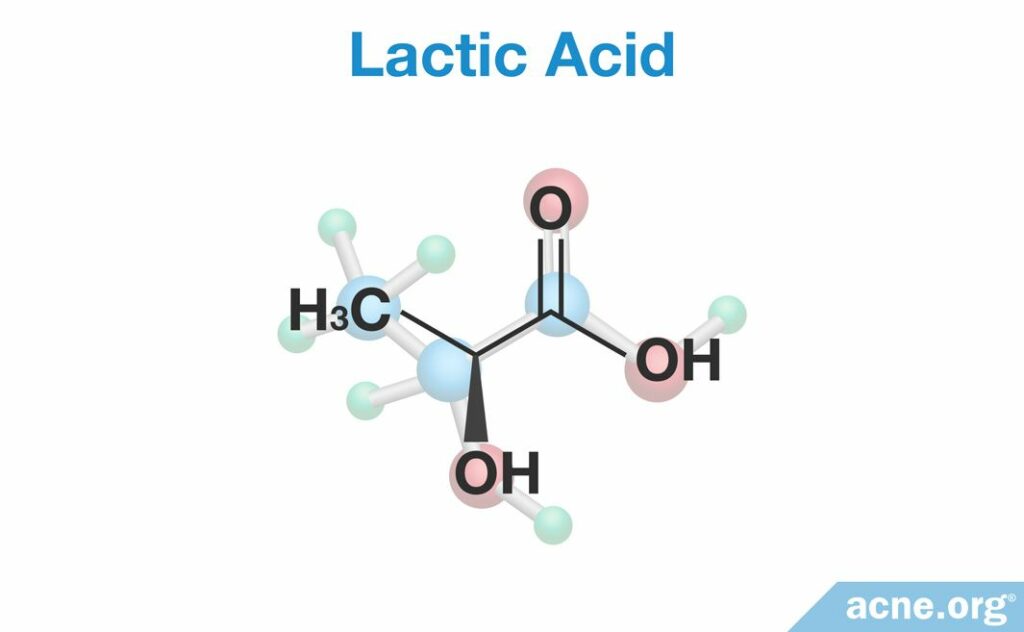
Lactic acid is an alpha hydroxy acid (AHA). Alpha hydroxy acids are a group of acids used to treat a variety of skin conditions, including acne, ichthyosis, keratosis, warts, psoriasis, and sun-damaged skin.
Lactic acid is a less common AHA for the treatment of acne, but it is often found in skin care products for its anti-aging effects. However, while lactic acid should also clear acne to some degree, like other AHAs, it is most effective when used in combination with acne medications.1
How Lactic Acid Works to Clear Acne
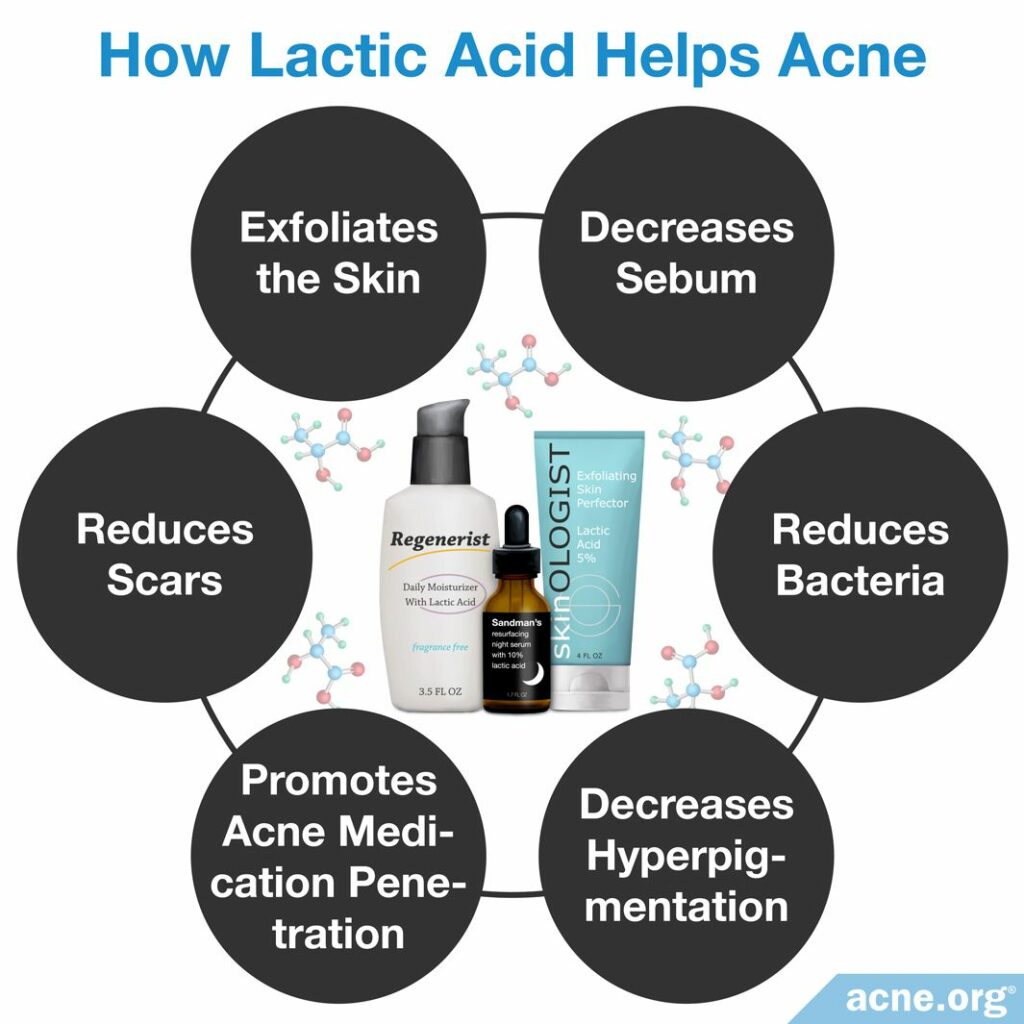
Lactic acid has several effects that help with acne as well as skin aging.
Here’s how it helps with acne:
- Exfoliates the skin: The accumulation of dead skin cells on the surface of the skin leads to clogged pores and acne. Exfoliation of the skin can thin the layer of dead skin cells, which helps to unclog pores that may develop into acne. Lactic acid works to exfoliate the skin by:
- Absorbing calcium: Alpha hydroxy acids can capture calcium particles. Calcium is an important mineral that latches onto the surface of skin cells and helps those cells to attach to other cells. Lactic acid absorbs this calcium, which causes the connections between skin cells to become weaker, and this helps to exfoliate the skin.
- Breaking down keratin: Skin cells called keratinocytes produce keratin, a “sticky” protein. Keratin causes skin cells to stick together like glue would, and this results in an accumulation of these cells on the surface of the skin. Acne-prone individuals often have more keratinocytes than non-acne-prone individuals, and this leads to more keratin and thus clogged pores and acne. Lactic acid can break down keratin and “pull apart” skin cells that are stuck together, and this helps clear the accumulated dead cells from the surface of the skin.
- Breaking down surface skin cells: Corneocytes are dead skin cells that the topmost layer of skin, called the stratum corneum, comprises. Lactic acid promotes the breakdown of corneocytes, and therefore promotes the thinning of the top layer of skin. Removing the corneocytes helps to exfoliate the skin, resulting in fewer clogged pores and less acne.
- Decreases skin oil: Healthy skin produces skin oil, called sebum. Sebum helps to keep the skin healthy and protected. Acne-prone individuals often produce too much sebum, which accumulates inside of a clogged pore and leads to acne. Lactic acid can decrease the amount of sebum the skin produces, which helps to prevent the formation of clogged pores.
- Reduces bacteria: A bacteria called C. acnes can rapidly grow inside a clogged pore. This bacteria makes acne worse by bringing about inflammation that can make the lesion red, swollen, and sore. This bacteria also triggers the creation of pus. Lactic acid demonstrates anti-bacterial properties, meaning that it can decrease the amount of C. acnes inside acne lesions.
- Decreases hyperpigmentation: After an acne lesion heals, it can leave behind red/dark marks. Dermatologists call these marks post-inflammatory hyperpigmentation, or just hyperpigmentation for short. Hyperpigmentation is more frequently found in people with non-Caucasian skin. Lactic acid can decrease hyperpigmentation by promoting the renewal of skin cells. Skin discoloration decreases because new skin cells rapidly replace the old, discolored cells, which evens out the color of the skin.2
- Promotes penetration of acne medications: To be effective at clearing acne, topical acne medications such as benzoyl peroxide need to penetrate into the skin. A layer of accumulated dead skin cells covering the skin’s surface can prevent medications from penetrating into the skin, which reduces their effectiveness. Lactic acid exfoliates the topmost layer of skin, and this allows for topical acne medications to penetrate the skin more easily, improving their effectiveness.
- Reduces scars: Severe acne lesions may leave behind scars. High-percentage lactic acid peels can help reduce scarring from acne lesions.1,4,5
- [Possible] Keeps inflammation under control: Research evidence is starting to come in suggesting that lactic acid may regulate the skin’s immune response and reduce inflammation.6 This idea makes sense based on what we already know about how lactic acid modulates immunity in the gut. We have billions of probiotic bacteria living in our intestines. Some of these bacteria produce lactic acid, which helps keep our intestinal tracts healthy by preventing inflammation. Some scientists suspect that lactic acid may play a similar role in the skin, keeping inflammation down. Inflammation in the skin is a key part of acne, so keeping inflammation in check would also help with acne.
Lactic acid also has anti-aging properties:
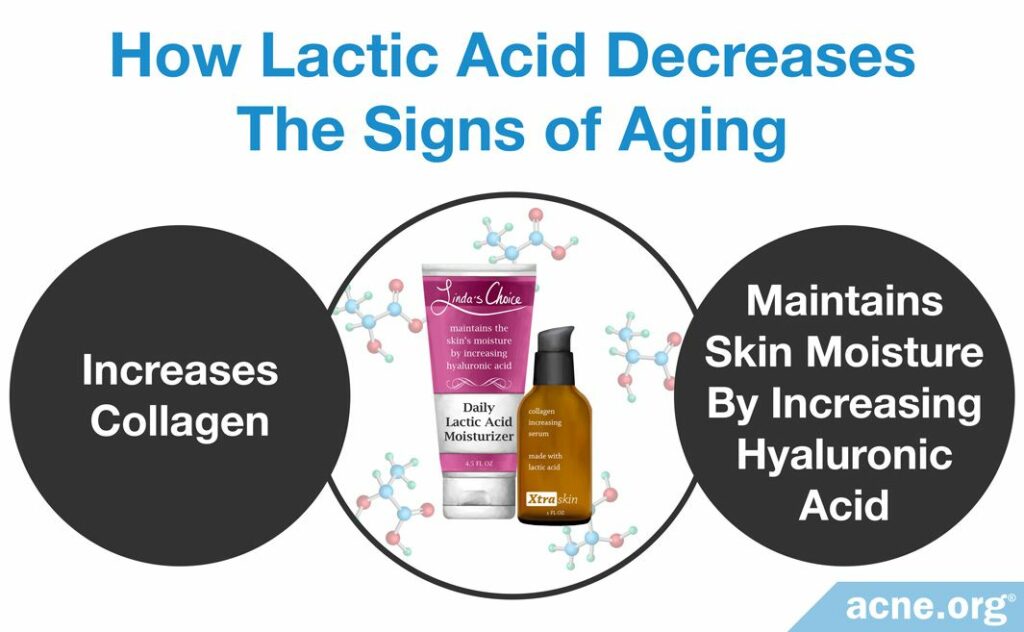
- Skin thickening: In healthy skin, collagen provides support and structure to the skin. If this collagen is damaged, or if the amount of collagen decreases, wrinkles form. Lactic acid can increase the amount of collagen, which helps the skin maintain its shape and strength.
- Skin hydration: Healthy skin must contain a certain amount of water, and without a proper level of moisture, the skin can become dry and flaky. This dryness can lead to skin damage and aging. Lactic acid works to maintain skin moisture by increasing the production of a compound called hyaluronic acid. Hyaluronic acid supports skin hydration, and the increase in moisture affects skin appearance, texture, and function.1
Lactic Acid Treatments for Acne
Lactic acid is available in:
- Over-the-counter products
- Professionally-administered chemical peels
Over-the-counter lactic acid products
Over-the-counter lactic acid products all contain concentrations less than 10%, but concentrations of 1.5%, 3%, and 5% are most common.
These products work by exfoliating the skin, decreasing sebum, fighting bacteria, increasing penetration of acne medications, and reducing hyperpigmentation and scars.
Due to the lower concentration, these products are safe for frequent use at home, and while they may clear acne to some degree, they are normally used alongside acne medications for the greatest effect.
Professionally-administered lactic acid peels
In addition to over-the-counter products, lactic acid can be applied in the form of a chemical peel. Lactic acid chemical peels can range in concentration from 20 – 70%.
Chemical peels are not over-the-counter and must always be administered by a professional, such as a nurse or esthetician, and should never be attempted at home.
A lactic acid chemical peel is generally not used for acne and instead is used for its anti-aging effects and to prevent wrinkle formation. Therefore, researchers have not performed research investigating how lactic acid chemical peels affect acne. However, because lactic acid is an AHA, researchers believe that a lactic acid chemical peel would work similarly to other AHA peels to clear acne.
Other AHA peels work to clear acne by:
- Exfoliating the skin: Alpha hydroxy acid exfoliates the layer of dead skin cells that can accumulate on the surface of the skin. Removing this dead skin cell layer helps to unclog pores.
- Removing the keratin plug: High-percentage AHA chemical peels can help remove keratin plugs, which are structures formed from keratin and corneocytes that clog the opening of the pore. The formation of a keratin plug can lead to acne, so removing keratin plugs can help prevent acne.
- Removing the contents of an acne lesion: The removal of a keratin plug enables the extrusion of the contents in clogged pores, which helps to clear them from the skin
It is unclear if lactic acid peels work the same way as other AHA peels to treat acne, but it is likely that they do.3,7
Characteristics That Affect the Strength of a Lactic Acid Product
When using lactic acid to treat acne, or for its anti-aging effect, there are two characteristics that can change its strength:
- Concentration
- pH (how acidic)
Concentration
- Lower concentration – over-the-counter products
Lactic acid products with concentrations up to 10% are safe for more frequent use and mild exfoliation of the skin. Often, over-the-counter lactic acid products contain concentrations less than this and are most commonly sold in 1.5%, 3%, or 5% concentrations. - Higher concentration – professionally-administered peels
Professionally-administered lactic acid peels can range in concentration from 20 – 70%, but a 70% chemical peel is the most common. These are most often used for their anti-aging effects. Lactic acid peels at these high concentrations should never be used at home.8
pH
pH is a scientific unit that measures the acidity of a compound. The pH scale ranges from 1 – 14, with “1” representing the most acidic substance and “14” representing the least acidic substance. For example, stomach acid has a pH of 2; water has a neutral pH of 7, and bleach has a pH of 12. The pH of the lactic acid peel can impact what effects it has on the skin and on acne. The lower the pH, the more effective lactic acid is at clearing acne, but a low pH also causes more side effects.
- Higher pH – over-the-counter products
The Food and Drug Administration (FDA) has determined that lactic acid used in over-the-counter products must have a pH of 3.5 or greater - Lower pH – professionally-administered peels
Professionally-administered lactic acid chemical peels can have a pH of up to 2. However, this low pH can lead to more severe side effects, and due to these side effects, lactic acid peels are only safe if professionally-administered.8
Lactic Acid Side Effects
The side effects of lactic acid products are generally unknown, but most researchers assume that because lactic acid is an AHA, its side effects are similar to those of other AHAs. Generally, the side effects of over-the-counter AHA products are mild, but professionally-administered AHA peels can cause more severe side effects.
Side effects of over-the-counter products
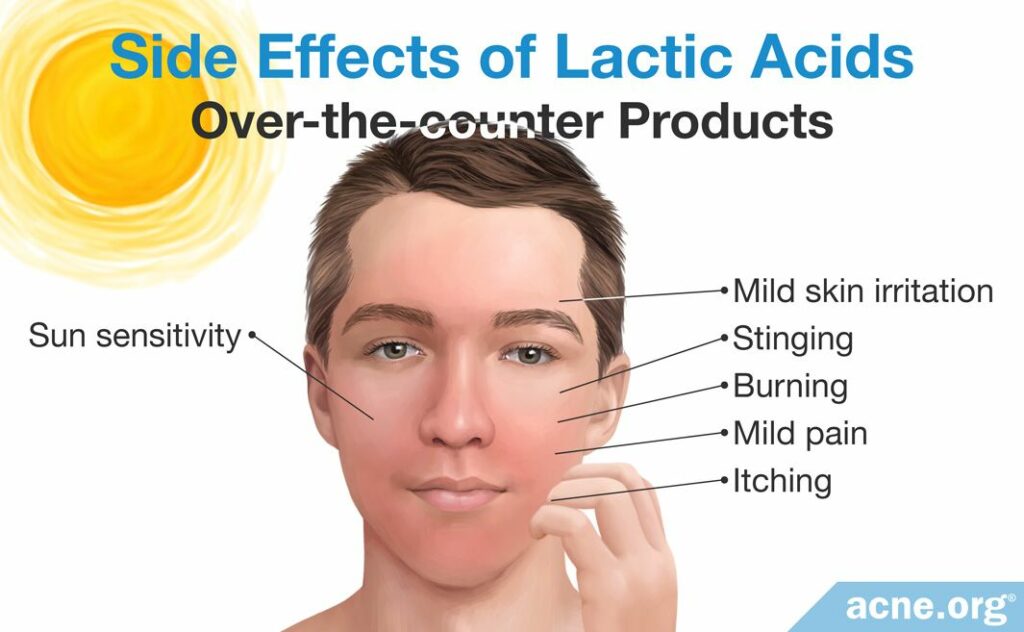
Over-the-counter lactic acid products may cause some mild side effects, including:
- Mild skin irritation
- Stinging
- Burning
- Mild pain
- Itching
- Increased sun sensitivity
Side effects of professionally-administered peels
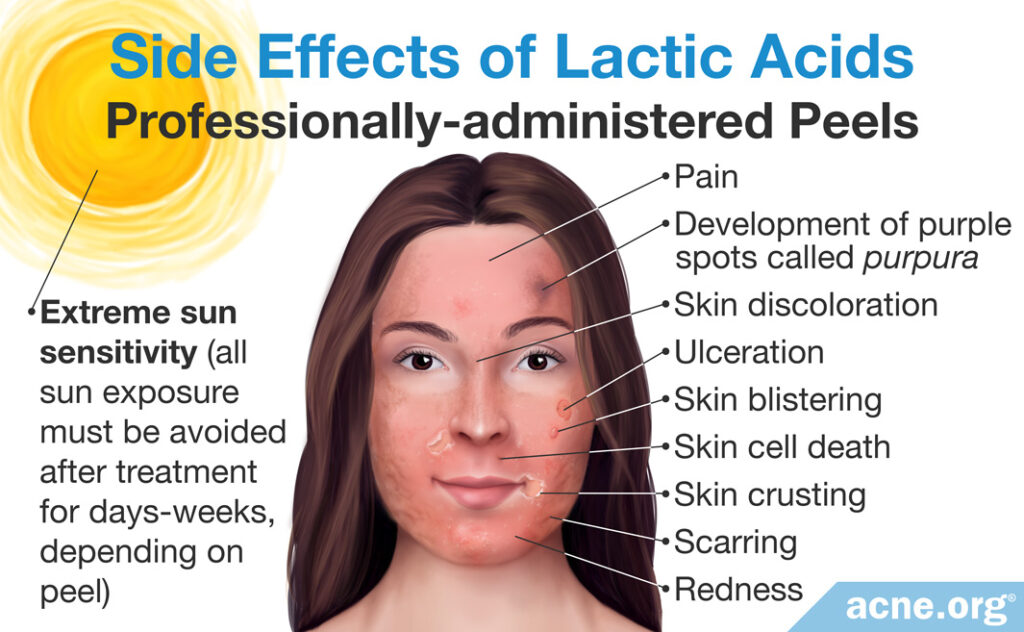
Lactic acid at a higher concentration and lower pH can cause much more severe side effects, including:
- Pain
- Skin blistering
- Development of purple spots called purpura
- Skin crusting
- Redness
- Skin discoloration
- Skin cell death
- Ulceration
- Scarring
How Well Lactic Acid Works on Acne

Lactic acid is not a common standalone treatment for acne, and because of this, there is only one study investigating its effect on acne. This 2004 study, published in the International Journal of Cosmetic Sciences, compared the effectiveness of a 2% lactic acid treatment to a 2% salicylic acid treatment. Salicylic acid, a common treatment for acne, is a beta hydroxy acid (BHA), which is also a hydroxy acid but differs from AHA in how it impacts the skin. The researchers performed this study by having 46 people with mild acne apply one of the treatments twice daily for 12 weeks. This research found that people using the lactic acid reported a 56% decrease in their acne comedones (whiteheads and blackheads). Therefore, the researchers concluded that people with mild forms of acne may benefit from lactic acid treatments.4
In addition, one small study tested a combination of 5% lactic acid, green tea, and bamboo extract as a treatment for acne. The researchers found that five treatment sessions using this combination of ingredients reduced acne severity from moderate to mild in 83% of study participants. However, since the treatment included three medicinal ingredients, it is impossible to say to what extent lactic acid itself was responsible for the results.9
How Well Lactic Acid Works on Acne Scars
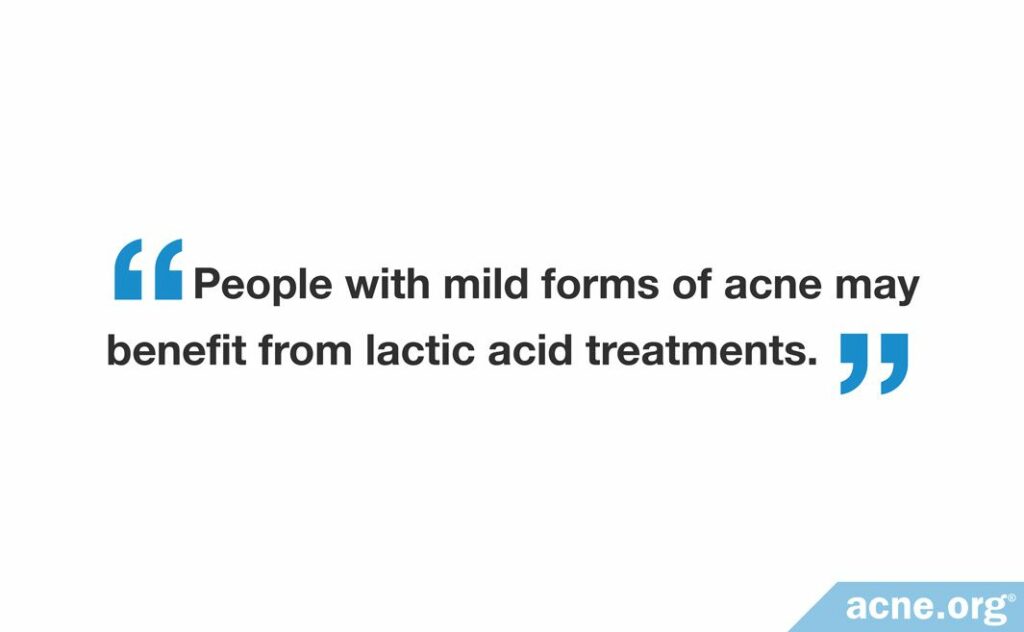

Similarly, little research has looked at lactic acid as a standalone treatment for acne scars. One small study, published in the Journal of Cosmetic Dermatology in 2010, found that a full-strength lactic acid peel improved superficial acne scars in patients of Indian background. The researchers gave each of the seven patients up to four peel treatments at 2-week intervals. They wrote, “At the end of 3 months, there was definite improvement in the texture, pigmentation, and appearance of the treated skin, with lightening of scars.”10
References
- Kornhauser, A., Coelho, S. G. & Hearing, V. J. Applications of hydroxy acids: classification, mechanisms, and photoactivity. Clin Cosmet Investig Dermatol 3, 135 – 142 (2010). https://www.ncbi.nlm.nih.gov/pmc/articles/PMC3047947/
- Bhardwaj, V., Sharma, K., Maksimovic, S., Fan, A., Adams-Woodford, A. & Mao, J. Professional-grade TCA-lactic acid chemical peel: Elucidating mode of action to treat photoaging and hyperpigmentation. Front Med (Lausanne) 8, 617068 (2021). https://pubmed.ncbi.nlm.nih.gov/33681250/
- Kessler, E., Flanagan, K., Chia, C., Rogers, C. & Glaser, D. A. Comparison of α- and β-hydroxy acid chemical peels in the treatment of mild to moderately severe facial acne vulgaris. Dermatol Surg 34, 45 – 51 (2008). https://www.ncbi.nlm.nih.gov/pubmed/18053051
- Scherdin, U. et al. In vivo assessment of the efficacy of an innovative face care system in subjects with mild acne vulgaris. Int J Cosmet Sci 26, 221 – 229 (2004). https://www.ncbi.nlm.nih.gov/pubmed/18492134
- Sadove, R. Injectable poly-L-lactic acid: a novel sculpting agent for the treatment of dermal fat atrophy after severe acne. Aesthetic Plast Surg 33, 113 – 116 (2009). https://www.ncbi.nlm.nih.gov/pmc/articles/PMC2696608/
- Tang, S. C. & Yang, J. H. Dual effects of alpha-hydroxy acids on the skin. Molecules 23, 863-875 (2018). https://pubmed.ncbi.nlm.nih.gov/29642579/
- Dréno, B. et al. Efficacy of superficial chemical peels in active acne management–what can we learn from the literature today? Evidence-based recommendations. J Eur Acad Dermatol Venereol 25, 695 – 704 (2011). https://www.ncbi.nlm.nih.gov/pubmed/21029205
- FDA. Alpha-Hydroxy Acids. https://www.fda.gov/cosmetics/productsingredients/ingredients/ucm107940.html
- Chilicka, K., Rogowska, A. M., Rusztowicz, M., Szyguła, R., Yanakieva, A., Asanova, B. & Wilczyński, S. The effects of green tea (Camellia sinensis), bamboo extract (Bambusa vulgaris) and lactic acid on sebum production in young women with acne vulgaris using sonophoresis treatment. Healthcare (Basel) 10, 684-698 (2022). https://pubmed.ncbi.nlm.nih.gov/35455861/
- Sachdeva, S. Lactic acid peeling in superficial acne scarring in Indian skin. J Cosmet Dermatol 9, 246-248 (2010). https://www.ncbi.nlm.nih.gov/pubmed/20883299
The post How Lactic Acid Helps with Acne appeared first on Acne.org.
